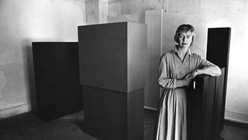
John Baldessari, I Will Not Make Any More Boring Art, 1971. Image Source: www.whitney.org
If you still don’t get it after two readings, I suggest you open your own art gallery and stock it with the work you believe is unrecognized. Many artists will be grateful, and you can look at what you want all day long.

Kasimir Malevich, Black Square, 1929. Image Source: paulcorio.blogspot.com
I am studying sculpture and painting in college and recently quit my job to focus on my art. I believe I can support myself with my work, but so far I have not made much money. I have pieces in several galleries and I paint small commissions every now and then, but I’ve turned my focus to exhibitions with cash prizes. I have some great ideas for submissions, but they are a far cry from the normal work I produce for the galleries around town. I worry that I will spend too much time on a piece that doesn’t win the exhibition and won’t make it into the gallery. My question is, as a beginning artist, which is more important for survival: producing pieces that will sell in a gallery setting, or producing pieces for exhibitions? I assumed galleries would be safer than relying on the possibility of a cash prize, but I’m not so sure now.
If survival is your first concern, I strongly recommend that you get a job again, one that is not too taxing on the brain or the back, and one which provides a steady income so that you can pay your bills and eat decent food and sleep in a warm, dry place.
I can understand why you might want to “focus on your work,” but it sounds to me like that’s not really what you’re doing right now. Usually, an artist quits her job when she already has a proven, steady income from her work (and usually only then if she makes quite a lot of money). That steady income is usually the result of two things: first, developing a distinct body of work (more about this in next week’s column), and then getting representation at more than one gallery. It sounds like you don’t have your ideas worked out enough to have developed your own artistic vocabulary: you’re doing commissions, your “normal” work for galleries, and spec work for theme shows. That’s a lot of studio time but maybe not a lot of actual focusing on the advancement of your art. If your focus is on making money, you’re better off having a nine-to-five job.

Agnes Martin, Untitled, 2004. Image Source: museum.foxajans.net
Until you’ve produced a lot of work, you won’t know what you want to focus on, so maybe it’s good that you’re trying out so many new things. However, I’d still advise you to avoid the juried theme shows unless you see one calling for the work that you already make. Otherwise, you’ll end up putting your time and energy into making work that is not part of your regular production, and then you run the risk of not having it accepted into the show anyway. Lots of people have good ideas (for example, I think of social practice-y projects all the time) but unless you’re a wealthy “short sleeper” you’re not going to have the time, money, or energy left for your own development.

Andy Warhol, Brillo Box, 1965. Image Source: www.rfc.museum
If you can get commissions and you like doing that kind of thing, why not pursue that avenue? As long as they dovetail nicely with your main interests (i.e., no one is asking you to paint sailboats when you’re really a minimalist sculptor) it’ll bring in some extra income, you’ll meet people and build a collector base, and you’ll still be working toward the development of your own work.






